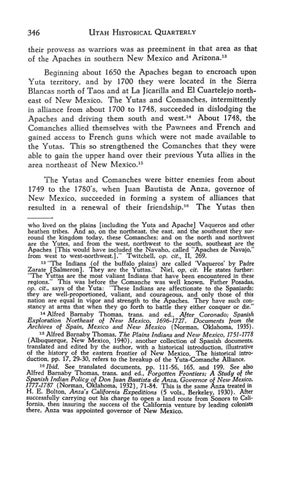346
U T A H HISTORICAL QUARTERLY
their prowess as warriors was as preeminent in that area as that of the Apaches in southern New Mexico and Arizona. 13 Beginning about 1650 the Apaches began to encroach upon Yuta territory, and by 1700 they were located in the Sierra Blancas north of Taos and at La Jicarilla and El Cuartelejo northeast of New Mexico. T h e Yutas and Comanches, intermittently in alliance from about 1700 to 1748, succeeded in dislodging the Apaches and driving them south and west. 14 About 1748, the Comanches allied themselves with the Pawnees and French and gained access to French guns which were not made available to the Yutas. This so strengthened the Comanches that they were able to gain the upper hand over their previous Yuta allies in the area northeast of New Mexico. 15 The Yutas and Comanches were bitter enemies from about 1749 to the 1780's, when Juan Bautista de Anza, governor of New Mexico, succeeded in forming a system of alliances that resulted in a renewal of their friendship. 16 T h e Yutas then who lived on the plains [including the Yuta and Apache] Vaqueros and other heathen tribes. And so, on the northeast, the east, and the southeast they surround the kingdom today, these Comanches; and on the north and northwest are the Yutes, and from the west, northwest to the south, southeast are the Apaches [This would have included the Navaho, called "Apaches de Navajo," from west to west-northwest.]." Twitchell, op. cit., II, 269. 13 "The Indians (of die buffalo plains) are called 'Vaqueros' by Padre "Zarate [Salmeron]. They are the Yuttas." Niel, op. cit. He states further: "The Yuttas are the most valiant Indians that have been encountered in these regions." This was before the Comanche was well known. Father Posadas, op. cit., says of the Yuta: "These Indians are affectionate to die Spaniards; diey are well-proportioned, valiant, and courageous, and only those of this nation are equal in vigor and strength to the Apaches. They have such constancy at arms that when they go forth to battle they either conquer or die." 14 Alfred Barnaby Thomas, trans, and ed., After Coronado; Spanish Exploration Northeast of New Mexico, 1696-1727. Documents from the Archives of Spain, Mexico and New Mexico (Norman, Oklahoma, 1935). 15 Alfred Barnaby Thomas, The Plains Indians and New Mexico, 1751-1778 (Albuquerque, New Mexico, 1940), another collection of Spanish documents, translated and edited by the author, with a historical introduction, illustrative of the history of the eastern frontier of New Mexico. The historical introduction, pp. 17, 29-30, refers to the breakup of the Yuta-Comanche Alliance. 16 Ibid. See translated documents, pp. 111-56, 165, and 199. See also Alfred Barnaby Thomas, trans, and ed., Forgotten Frontiers; A Study of the Spanish Indian Policy of Don Juan Bautista de Anza, Governor of New Mexico, 1777-1787 (Norman, Oklahoma, 1932), 71-84. This is the same Anza treated in H. E. Bolton, Anza's California Expeditions (5 vols., Berkeley, 1930). After successfully carrying out his charge to open a land route from Sonora to California, then insuring the success of the California venture by leading colonists there, Anza was appointed governor of New Mexico.















